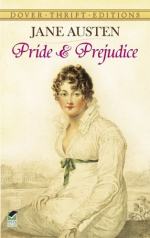|
This section contains 423 words (approx. 2 pages at 400 words per page) |

|
Pride and Prejudice Summary & Study Guide Description
Pride and Prejudice Summary & Study Guide includes comprehensive information and analysis to help you understand the book. This study guide contains the following sections:
This detailed literature summary also contains Bibliography and a Free Quiz on Pride and Prejudice by Jane Austen.
Jane Austen's Pride and Prejudice had a long and varied life before it finally saw publication on January 28, 1813 Austen began the book, originally titled First Impressions, In 1796 Her father submitted it to a London publisher the following year, but the manuscript was rejected. Austen continued to work on the book, and scholars report that the story remained a favorite with the close circle of friends, relations, and acquaintances she took into her confidence. She probably continued working on First Impressions after her family relocated to Bath in 1801 and did not stop revising and rewriting until after the deaths of both her father and a close friend in 1805. After this point Austen seems to have given up writing for almost five years. She had resumed work on the book by 1811, scholars report, and the final product appeared anonymously in London bookstalls early in 1813.
The critical history of Pride and Prejudice was just as varied as the evolution of the novel itself. At the time the novel was published in the early nineteenth century, most respected critical opinion was strongly biased against novels and novelists. Although only three contemporary reviews of Pride and Prejudice are known to exist, they are all remarkably complimentary. Anonymous articles in the British Critic and the Critical Review praised the author's characterization and her portrayal of domestic life. Additional early commentary exists in the diaries and letters of such prominent contemporary readers as Mary Russell Mitford and Henry Crabb Robinson, both of whom admired the work's characters, realism, and freedom from the trappings of Gothic fiction. After this period, however, criticism of Pride and Prejudice, and of Austen's works as a whole, largely disappeared. With the exception of two posthumous appreciations of Austen's work as a whole by Sir Walter Scott and Archbishop Richard Whateley, very little Austen criticism appeared until 1870.
In 1870, James Edward Austen-Leigh, son of Jane Austen's brother James, published A Memoir of Jane Austen, by Her Nephew. This biography was the first major study of Austen as a person and as an artist, and it marked the beginning of a new era in Austen criticism. Although most critics no longer accept its conclusion that Austen was an "amateur genius" whose works were largely unconscious productions of her fertile imagination, it nonetheless performed a valuable service by bringing Austen and her works back into critical attention. Modem critical opinion of Austen began with the publication in 1939 of Mary Lascelles's Jane Austen and Her Art, which escaped from the Victorian portrait of Austen put forth by Austen-Leigh.
Read more from the Study Guide
|
This section contains 423 words (approx. 2 pages at 400 words per page) |

|



